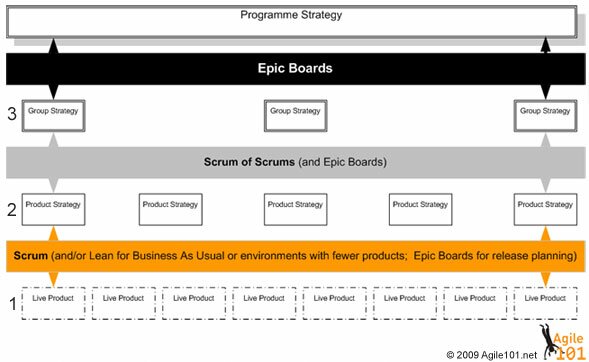Lean, Scrum, Scrum of Scrums and Epic Boards!
As touched upon in my post about Managing Scrum Projects alongside BAU, Scrum is most perfectly (easily) applied to scenarios with fewer product owners, fewer teams with common goals. I’d even go so far as to say that it is relatively easy to scale scrum across multiple teams with multiple product owners assuming they share common goals.
The challenge is maintaining communication/awareness across the product management hierarchy – particularly as you start to increase the number of products and portfolios of products. So, when do you use Scrum practices, when should you consider Lean practices and when should you consider using Epic Boards?
In short, any Scrum of Scrums scenario could benefit from being hosted around an Epic board. It could not and should not replace a task board, it’s just a higher-level view of what’s going on.
I’ve identified three layers of hierarchy as a starting point:

Layer 1:The Agile Development Team and their Product(s)
This layer represents the ‘front-line’, the delivery team and the end product.
Scrum is best applied to this level i.e. one Team (or set of teams with a common goal), One Product Owner, One Product. This is also the situation where one can use a Lean approach – communication must be particularly strong in this case. The important thing to point out is that the communication in this situation is primarily focused at a sprint-level.
Business As Usual Teams may also find the need to introduce the concept of Stretch Tasks into a sprint i.e. the ‘next’ highest priority user stories that would otherwise be delivered in the following sprint. Some teams purposefuly under commit during particularly uncertain times and fill the spare capacity (should it materialise) with the highest priority task at the point they become available to start something new – this is more of a Lean approach.
Scrum Teams may also use an Epic Board or a Release Board to track progress across sprints to ensure they are achieving long-term objectives.
Layer 2: The Product Owner(s) and the Portfolio Owners
This layer represents the communication channels existing between the Product Owner and the Portfolio Owners.
One of the challenges within this situation is managing priorities between multiple sprints, projects and products. This is where Scrum of Scrums and Epic Boards (Programme Management) becomes increasingly useful to track dependencies and progress.
Layer 3: The Portfolio Owners and the Programme Owner
At this level you are managing multiple portfolios of products comprising multiple projects. This is where you become reliant upon the Epic Board and Programme Planning Meetings to track progress and communicate priorities.
For more information about Epic Boards read on.
Subscribe to the Agile101 RSS to be notified when I upload new Articles Templates and Tips!
Related articles:
- Does Agile Programme Management Exist (agile101)
- Agile Programme Management Increases Flexibility (agile101)
- The Epic Board – An Essential Agile Project Management Tool (agile101)
- Using Scrum on Larger Projects: “Scrum of Scrums” (agile-software-development.com)
